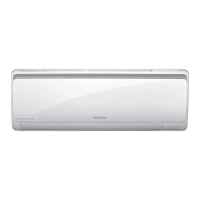
Do you have a question about the Samsung MH035FNEA and is the answer not in the manual?
| Indoor units quantity | 1 |
|---|---|
| Indoor unit dimensions (WxDxH) | 825 x 189 x 285 mm |
| Indoor unit noise level (high speed) | 36 dB |
| Type | Air conditioner indoor unit |
| Cooling capacity (max) | - BTU/h |
| Air conditioner functions | cooling, heating |
| Cooling capacity in watts (max) | 3500 W |
| Heating capacity in watts (max) | 3800 W |
| Outdoor units quantity | 0 |
| Power requirements | 220 - 240 V, 50 Hz |
| Power consumption (typical) | 35 W |
Guidelines for safe installation to prevent hazards like fire, water leaks, or electric shock.
Rules for safe electrical connection, including independent circuits and proper wiring practices.
Safety measures for operating the unit, including keeping children away and proper ventilation.
Procedures for safe and environmentally sound disposal of the air conditioner and its components.
General safety advice on handling, storing, and specific procedures like pump down.
Overview of key features like Multi Inverter, installation flexibility, and operational characteristics.
Detailed technical data for indoor and outdoor units, including performance, dimensions, and electrical specs.
Comparison of product specifications, design, and net weight between different models.
Lists of indoor unit accessories and filters with part numbers, quantities, and remarks.
Step-by-step procedures for disassembling the outdoor unit, including necessary tools and safety notes.
Guide to indoor/outdoor unit error codes, explanations, and main checking points for diagnosis.
Instructions on how to enter setup mode and select options using the remote control for various functions.
Essential pre-checks and common operational symptoms to diagnose potential issues before detailed troubleshooting.
Procedures for installation checks, PCB display settings, and pipe connection tests for system verification.
Diagnostic flowcharts for common indoor and outdoor unit faults based on specific symptoms and error codes.
Cautions and procedures for inspecting Printed Circuit Boards (PCBs), including soldering and replacement guidelines.
Exploded diagrams and detailed parts lists for various indoor unit models, identifying all components.
Exploded diagrams and detailed parts lists for various outdoor unit models, identifying all components.
Detailed diagrams illustrating the layout and connections of indoor unit Printed Circuit Boards (PCBs).
Detailed diagrams illustrating the layout and connections of outdoor unit Printed Circuit Boards (PCBs).
Comprehensive wiring diagrams showing electrical connections for indoor units and their components.
Comprehensive wiring diagrams detailing electrical connections for outdoor units and their various models.
Electrical schematic diagrams for indoor units, illustrating circuit logic and component functions.
Electrical schematic diagrams for outdoor units, detailing circuit design and component functions.
Guidelines for selecting optimal indoor and outdoor unit installation locations for performance and longevity.
Step-by-step instructions for connecting refrigerant pipes and purging air from the system.
Procedure for refilling refrigerant into the air conditioner after installation or leak, ensuring correct levels.
Guidelines for adjusting refrigerant quantity based on pipe length and installation conditions for optimal performance.
Specifies the correct torque values for tightening flare nuts on refrigerant pipes for secure connections.
Procedure for safely transferring refrigerant before unit relocation or component replacement to maintain system integrity.
Explains the structure and meaning of model names, including product type, capacity, and features.
Visual diagrams illustrating the refrigerant flow and component relationships in various outdoor unit models.
Table defining units of measurement for pressure and capacity, such as W, cal/s, Btu/h, and HP.
Glossary defining technical terms and abbreviations used throughout the manual for clarity.
Frequently asked questions and answers covering common issues like cooling, leakage, smells, and operation problems.
Basic principles of refrigeration and air supply, explaining factors affecting air quality and freshness.












